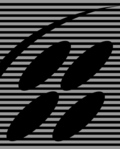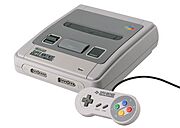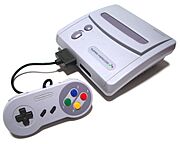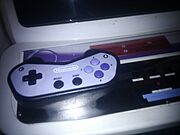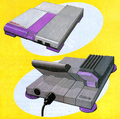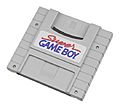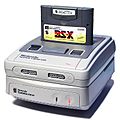Super Nintendo Entertainment System facts for kids
 |
|
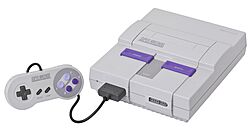 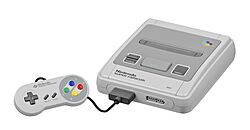
|
|
| Also known as | SNES Super NES
|
|---|---|
| Developer | Nintendo R&D2 |
| Manufacturer | Nintendo |
| Type | Home video game console |
| Generation | Fourth |
| Release date |
|
| Retail availability | 1990–2005 |
| Introductory price | ¥25,000 (equivalent to ¥27,804 in 2019) US$199 (equivalent to $427.56 in 2022) |
| Discontinued |
|
| Units sold |
|
| Media | ROM cartridge |
| CPU | Ricoh 5A22 @ 3.58 MHz |
| Sound | Nintendo S-SMP |
| Online services | Satellaview (Japan only) XBAND (US and Canada only) Nintendo Power (Japan only) |
| Best-selling game |
|
| Predecessor | NES |
| Successor | Nintendo 64 |
The Super Nintendo Entertainment System, commonly shortened to Super Nintendo, Super NES or SNES, is a 16-bit home video game console developed by Nintendo that was released in 1990 in Japan and South Korea, 1991 in North America, 1992 in Europe and Oceania and 1993 in South America. In Japan, it is called the Super Famicom (SFC). In South Korea, it is called the Super Comboy and was distributed by Hyundai Electronics. The system was released in Brazil on August 30, 1993, by Playtronic. Although each version is essentially the same, several forms of regional lockout prevent cartridges for one version from being used in other versions.
The Super NES is Nintendo's second programmable home console, following the Nintendo Entertainment System (NES). The console introduced advanced graphics and sound capabilities compared with other systems at the time, like the Sega Genesis. It was designed to accommodate the ongoing development of a variety of enhancement chips integrated into game cartridges to be more competitive into the next generation.
The Super NES received largely positive reviews and was a global success, becoming the bestselling console of the 16-bit era after launching relatively late and facing intense competition from Sega's Genesis console in North America and Europe. Overlapping the NES's 61.9 million unit sales, the Super NES remained popular well into the 32-bit era, with 49.1 million units sold worldwide by the time it was discontinued in 2003. It continues to be popular among collectors and retro gamers, with new homebrew games and Nintendo's emulated rereleases, such as on the Virtual Console, the Super NES Classic Edition, Nintendo Switch Online; as well as several non-console emulators which operate on a desktop computer or mobile device, such as Snes9x.
History
To compete with the popular Family Computer in Japan, NEC Home Electronics launched the PC Engine in 1987, and Sega followed suit with the Mega Drive in 1988. The two platforms were later launched in North America in 1989 as the TurboGrafx-16 and the Sega Genesis respectively. Both systems were built on 16-bit architectures and offered improved graphics and sound over the 8-bit NES. It took several years for Sega's system to become successful. Nintendo executives were in no rush to design a new system, but they reconsidered when they began to see their dominance in the market slipping. Bill Mensch, the co-creator of the 8-bit MOS Technology 6502 microprocessor and founder of the Western Design Center (WDC), gave Ricoh the exclusive right to supply 8-bit and 16-bit WDC microprocessors for the new system. Meanwhile, Sony engineer Ken Kutaragi reached an agreement with Nintendo to design the console's sound chip without notifying his supervisors, who were enraged when they discovered the project; though Kutaragi was nearly fired, then-CEO Norio Ohga intervened in support of the project and gave him permission to complete it.
On September 9, 1987, then-Nintendo president Hiroshi Yamauchi revealed the development of the Super Famicom in the newspaper Kyoto Shimbun. On August 30, 1988, in an interview with TOUCH Magazine, Yamauchi announced the development of Super Mario Bros. 4, Dragon Quest V, three original games, and he projected sales of 3 million units of the upcoming console. Famicom Hissyoubon magazine speculated that Yamauchi's early announcement was probably made to forestall Christmas shopping for the PC Engine, and relayed Enix's clarification that it was waiting on sales figures to select either PC Engine or Super Famicom for its next Dragon Quest game. The magazine and Enix both expressed a strong interest in networking as a standard platform feature. The console was demonstrated to the Japanese press on November 21, 1988, and again on July 28, 1989.
Launch
Designed by Masayuki Uemura, the designer of the original Famicom, the Super Famicom was released in Japan on Wednesday, November 21, 1990, for ¥25,000 (equivalent to ¥27,804 in 2019). It was an instant success. Nintendo's initial shipment of 300,000 units sold out within hours.
With the Super Famicom quickly outselling its rivals, Nintendo reasserted itself as the leader of the Japanese console market. Nintendo's success was partially due to the retention of most of its key third-party developers, including Capcom, Konami, Tecmo, Square, Koei, and Enix.
Nintendo released the Super Nintendo Entertainment System, a redesigned version of the Super Famicom, in North America for US$199 (equivalent to $430 in 2022). It began shipping in limited quantities on August 23, 1991, with an official nationwide release date of September 9, 1991. The Super NES was released in the United Kingdom and Ireland in April 1992 for GB£150 (equivalent to £220 in 2021).
Most of the PAL region versions of the console use the Japanese Super Famicom design, except for labeling and the length of the joypad leads.
Hardware
Technical specifications
The 16-bit design of the Super NES incorporates graphics and sound co-processors that perform tiling and simulated 3D effects, a palette of 32,768 colors, and 8-channel ADPCM audio. These base platform features, plus the ability to dramatically extend them all through substantial chip upgrades inside of each cartridge, represent a leap over the 8-bit NES generation and some significant advantages over 16-bit competitors such as the Genesis.
CPU and RAM
The CPU is a Ricoh 5A22, which is a derivative of the 16-bit WDC 65C816 microprocessor. In NTSC regions, its nominal clock speed is 3.58 MHz but the CPU will slow down to either 2.68 MHz or 1.79 MHz when accessing some slower peripherals.
This CPU has an 8-bit data bus and two address buses. The 24-bit "Bus A" is designated for general accesses, and the 8-bit "Bus B" can access support chip registers such as the video and audio co-processors.
The WDC 65C816 supports an 8-channel DMA unit, an 8-bit parallel I/O port a controller port interface circuits allowing serial and parallel access to controller data, a 16-bit multiplication and division unit, and circuitry for generating non-maskable interrupts on V-blank and IRQ interrupts on calculated screen positions.
Early revisions of the 5A22 used in SHVC boards are prone to spontaneous failure which can produce a variety of symptoms including graphics glitches in Mode 7, a black screen on power-on, or improperly reading the controllers. The first revision 5A22 has a fatal bug in the DMA controller that can crash games; this was corrected in subsequent revisions.
The console contains 128 KB of general-purpose RAM, which is separate from the 64 KB VRAM and 64 KB ARAM dedicated to the video and audio subsystems respectively.
Video
The Picture Processing Unit (PPU) consists of two closely tied IC packages. It contains 64 KB of SRAM for video data, 544 bytes of object attribute memory (OAM) for sprite data, and 256 × 15 bits of color generator RAM (CGRAM) for palette data. This CGRAM provisions up to 256 colors, chosen from the 15-bit RGB color space, from a palette of 32,768 colors. The PPU is clocked by the same signal as the CPU and generates a pixel every two or four cycles.
Audio
The S-SMP audio chip consists of an 8-bit CPU, a 16-bit DSP, and 64 KB of SRAM. It was designed by Ken Kutaragi and produced by Sony and is completely independent from the rest of the system. It is clocked at a nominal 24.576 MHz in both NTSC and PAL systems. It is capable of stereo sound, composed from 8 voices generated using 8 bit audio samples and capable of applying effects such as echo.
Regional lockout
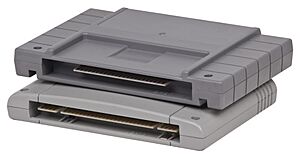
Nintendo employed several types of regional lockout, including both physical and hardware incompatibilities.
Physically, the cartridges are shaped differently for different regions. North American cartridges have a rectangular bottom with inset grooves matching protruding tabs in the console, and other regions' cartridges are narrower with a smooth curve on the front and no grooves. The physical incompatibility can be overcome with the use of various adapters, or through modification of the console.
Internally, a regional lockout chip (CIC) within the console and in each cartridge prevents the PAL region games from being played on Japanese or North American consoles and vice versa. The Japanese and North American machines have the same region chip. This can be overcome through the use of adapters, typically by inserting the imported cartridge in one slot and a cartridge with the correct region chip in a second slot. Alternatively, disconnecting one pin of the console's lockout chip will prevent it from locking the console; hardware in later games can detect this situation, so it became common to install a switch to reconnect the lockout chip as needed.
PAL consoles face another incompatibility when playing out-of-region cartridges: the NTSC video standard specifies video at 60 Hz but PAL operates at 50 Hz, resulting in an approximately 16.7% slower framerate. PAL's higher resolution results in letterboxing of the output image. Some commercial PAL region releases exhibit this same problem and, therefore, can be played in NTSC systems without issue, but other games will face a 20% speedup if played in an NTSC console. To mostly correct this issue, a switch can be added to place the Super NES PPU into a 60 Hz mode supported by most newer PAL televisions. Later games will detect this setting and refuse to run, requiring the switch to be thrown only after the check completes.
Casing
- SNES control deck variants
All models of the Super NES control deck are predominantly gray, of slightly different shades. The original North American version, designed by Nintendo of America industrial designer Lance Barr (who previously redesigned the Famicom to become the NES), has a boxy design with purple sliding switches and a dark gray eject lever. The loading bay surface is curved, both to invite interaction and to prevent food or drinks from being placed on the console and spilling as with the flat-surfaced NES. The Japanese and European versions are more rounded, with darker gray accents and buttons.
All versions incorporate a top-loading slot for game cartridges, although the shape of the slot differs between regions to match the different shapes of the cartridges. The MULTI OUT connector (later used on the Nintendo 64 and GameCube) can output composite video, S-Video and RGB signals, as well as RF with an external RF modulator. Original versions additionally include a 28-pin expansion port under a small cover on the bottom of the unit and a standard RF output with channel selection switch on the back; the redesigned models output composite video only, requiring an external modulator for RF.
The Nintendo Super System (NSS) is an arcade system for retail preview of 11 particular Super NES games in the United States, similar to the PlayChoice-10 for NES games. It consists of slightly modified Super NES hardware with a menu interface and 25-inch monitor, that allows gameplay for a certain amount of time depending on game credits. Manufacturing of this model was discontinued in 1992.
Redesigned model
A cost-reduced version of the console, referred to as the New-Style Super NES (model SNS-101) in North America and as the Super Famicom Jr. in Japan, was released late in the platform's lifespan; designed by Barr, it incorporates design elements from both the original North American and Japanese/European console models but in a smaller form factor. Unlike the original console models, the redesigned model is virtually identical across both regions save for the color palette. The redesign did not receive a release in Europe.
Externally, the power and reset buttons were moved to the left-hand side of the console while the cartridge eject button and power LED indicator were omitted. Internally, the redesigned model consolidates the console's hardware into a system-on-chip (SoC) design. The redesigned console lacks the bottom expansion slot, rendering it incompatible with the Japan-exclusive Satellaview add-on.
For AV output, the redesigned console features the same multi-out port used on the original models. Unlike the latter models, the former's AV port only supports composite video output natively as support for RGB video and S-Video was disabled internally; however, they can be restored via a "relatively simple" modification. The internal RF modulator was also removed, requiring an external one for such output if needed. Due to the SoC design, it is highly sought after by Super NES/Famicom enthusiasts since its RGB video quality (if restored) is improved over earlier internal revisions of the console.
The redesigned console first released in October 1997 in North America, where it originally retailed for US$99.95 in a bundle with Super Mario World 2: Yoshi's Island; it was subsequently released in Japan on March 27, 1998, where it retailed for ¥7,800. Nintendo marketed it as an entry-level gamer's system for consumers who were apprehensive about the higher price of newer systems such as the Nintendo 64. Nintendo also introduced a slightly altered controller for it, with the console's logo replaced by an embossed Nintendo logo.
Yellowing
The ABS plastic used in the casing of some older Super NES and Super Famicom consoles is particularly susceptible to oxidation with exposure to air. This, along with the particularly light color of the original plastic, causes affected consoles to quickly become yellow; if the sections of the casing came from different batches of plastic, a "two-tone" effect results. This issue may be reversed with a method called Retrobrighting, where a mixture of chemicals is applied to the case and exposed to UV light.
Game cartridge
Super NES games are distributed on ROM cartridges, officially referred to as Game Pak in most Western regions, and as Cassette (カセット, Kasetto) in Japan and parts of Latin America. Though the Super NES can address 128 Mbit, only 117.75 Mbit are actually available for cartridge use. A fairly normal mapping could easily address up to 95 Mbit of ROM data (48 Mbit at FastROM speed) with 8 Mbit of battery-backed RAM. Most available memory access controllers only support mappings of up to 32 Mbit. The largest games released (Tales of Phantasia and Star Ocean) contain 48 Mbit of ROM data, and the smallest games contain only 2 Mbit.
Cartridges may also contain battery-backed SRAM to save the game state, extra working RAM, custom coprocessors, or any other hardware that will not exceed the maximum current rating of the console.
Notable Games
- Super Mario World
- Super Castlevania IV
- Super Mario RPG: Legend of the Seven Stars
- Super Metroid
- Donkey Kong Country
- EarthBound
- The Legend of Zelda: A Link to the Past
- Super Mario Kart
- Super Mario World 2: Yoshi's Island
- F-Zero
- Star Fox
Images for kids
-
The Super Game Boy allows Game Boy games to be played on the SNES
-
Satellaview with Super Famicom
See also
 In Spanish: Super Nintendo para niños
In Spanish: Super Nintendo para niños



